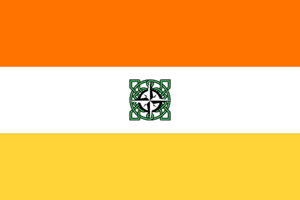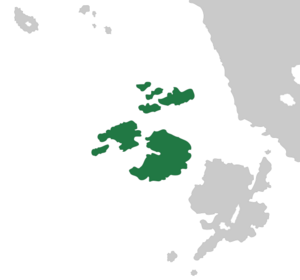New Ardmore: Difference between revisions
mNo edit summary |
m (→Economy) |
||
| Line 174: | Line 174: | ||
[[Category:IXWB]] | [[Category:IXWB]] | ||
[[Category:Ardmore]] | |||
Revision as of 15:55, 15 December 2022
This article is non-canonical either because it refers to out-of-character content, the associated nations have left the region, or the information has been retconned. Accordingly, its content should not be considered to be part of the canonical structure of the region's lore.
|
| Free State of New Ardmore Saorstát Aird Mhóir Nua (Gaelic) Helviārka Inox Ardmór (Coscivian) | |
 Flag | |

| |
| Sovereignty | |
| Theme | |
| Capital | Ardagh (Ardağon) |
| Largest City | Baltimore-Dundalk |
| Population | 3,531,159 |
| Ceann Stáit | Martin Umhaill (FAM) |
| Tánaiste | Máire mac Dubhghaill (FAM) |
| Stanora seats | 3 |
| Official languages | Ardmorean Gaelic, Kalvertan Coscivian |
| Postal Abbreviation | ARD |
New Ardmore (Gaelic: Ardmór Nua, Kiravic: Inoardmóra) is an overseas region of the Kiravian Collectivity comprising an archipelago in the Odoneru Ocean. Laying off the coast of mainland Levantia north of Ardmore, New Armore has a predominantly Garán heritage it shares with Ardmore and the Urcean region of Carolina, with further influences from Kiravia, to which it has been politically linked for over XX years. Originating as a rump state of Ardmore, the territories of New Ardmore - initially the Republic of Ardmore - became a formal protectorate of Kiravia in 19XX, with further integration establishing it as a free state under the Collectivity.
History
Pre-civil war
Sunderance
After the Kirosocialist takeover of the Kiravian mainland, Ardmore did not recognise the Kiravian Union, instead remaining loyal to the Kiravian Remnant. Kirosocialism had never been popular in the islands, which had only a small industrial sector and rather narrow wealth disparities. Early on, Ardmore was considered a desirable haven for émigrés departing from the Eastern Seaboard. Koskenkorva was cold and underdeveloped, and the Suderavian economy was under great strain due to the sudden influx of refugees. In contrast, Ardmore was warm and well-supplied, with secure lines of communication to Æonara, and was particularly inviting to Gaelic-speaking émigrés. However, with the defeat of the Farravonian Counterrevolution and the fall of Koskenkorva, it found itself in a less favourable position, which became acutely precarious in 1948 AD with the outbreak of the Carnish Revolution. With a communist victory looming in Carna and the overextended Remnant reeling from its defeats in Farravonia and Koskenkorva, the Kiravian administration of the islands urgently appealed to Urcea for aid. The Urcean government under [Procurator of the time] responded with a rapid deployment of the Royal and Imperial Army to the imperilled archipelago.
Although Ardmore would nominally maintain its allegiance to the Kiravian Remnant for the duration of the Sunderance, electing Delegates to the Rump Stanora and all that, the local administration came to operate largely independently of the Æonara authorities in its internal affairs, who were preöccupied with the Western Hemisphere and content to hold Ardmore by a long leash. Direct federal taxation of Ardmore was suspended by the Rump Stanora in [YEAR]. At the same time, Ardmore began to function as a de facto Urcean protectorate, becoming more reliant on the Apostolic Kingdom not only for military protection, but also for financial support, indirect diplomatic representation in many matters, and trade. Cut off from the Kiravian Union and Carnish economies, the economy of New Ardmore naturally reoriented itself toward Urcea and South Levantia, and the geopolitical worldview of its leadership and public shifted in this direction as well. Following the formation of the Levantine Union, Ardmore participated in the Levantine integration process on a bilateral basis, concluding a number of agreements with the supranational union and implementing many internal regulatory reforms to maintain synchrony with the LU economic space as it evolved.
Post-Sunderance
[Post-Kirsok]
Government
| Member | Party | First Elected | |
|---|---|---|---|
| Angus MacIntyre | Fíanna Aird Mor (KR) | 21201 | |
| Séamus Ó Dónaill | Fíanna Aird Mor (KR) | 21201 | |
| Tomás Ó Flaithbertaigh | Aontú (CSU) | 21201 | |
Relations with the Levantine Union
Political Landscape
The main divide in New Ardmore's political culture is between those with a more Levantine outlook - oriented toward Urcea and Fíannria and generally in favour of closer integration with the Levantine Union, and those with a more Boreal outlook - oriented toward Kiravia and Faneria and generally in favour of closer integration with the wider Kiravian Collectivity and Federacy.
| Party | Seats | Caucus | Platform | |
|---|---|---|---|---|
| PARTY NAME AMA PLAIDUL |
22 / 42 |
RKC | Centrism, Levantinism | |
| Republican-Renaissance Party Plaiduv Kéarita'inoguamsk |
10 / 42 |
SRA | Conservatism, Borealism | |
| Levantian Union Party Levantiax Anūrarisēx Plaiduv |
3 / 42 |
none | Levantinism (pro-accession), Liberal conservatism | |
| Aontú Întúv |
5 / 42 |
CSU | Christian democracy, Status-quo | |
| Other Party Plaiduv Inox Isdul |
1 / 42 |
NDA | Doin' ur mom. | |
| Whiggamore Party Ƕigamórix Plaiduv |
1 / 42 |
KFA | Doin' ur mom. | |
| JACOBITES??? Íakovindurya??? |
1 / 42 |
KFA | Doin' ur mom. |
Local Governance
Administratively, New Ardmore is divided into twenty countyships (siorrachdan). These are subdivided into burghs in built-up areas and hundreds in rural areas, both of which are in turn subdivided into townlands.
The Kiravian addressing system is in use in New Ardmore, with lots being numbered within townlands or quarters. Numbered blocks (ram) and circuits (kontruv) are rare outside of some newer suburban developments near Dundalk, with most address components represented by common geographic names.
Law
The legal system of New Ardmore is based heavily on Brehon law principles and traditions, especially in matters of civil law or equity, and Brehon law was the main mechanism for social regulation and dispute resolution in Ardmore for most of its history, supplemented by canon law with the coming of Christianity. As statelike institutions began to replace clan-based governance, Ardmorean law took cues from Urcean jurisprudence while retaining most of its traditional character, and since integration with Kiravia it has been influenced by Cosco-Kiravian law.
New Ardmore adopted a moratorium on capital punishment in 21196. Traditionally, most executions were carried out by firing squad on a sandspit called Deadman's Point, located three kilometers from Ardagh.
Society

Ardmore has an Insular Celtic culture with noticeable traces of Pretannic influence from early in its history, shaped by local geographic and climatic conditions, the Catholic faith, and contact with Coscivian civilisation by virtue of its status as a Kiravian federal subject. The state is rather homogeneous: 88% of the population of New Ardmore are ethnic Gaels. Most of the remainder are Coscivian-Kiravians or of Levantine backgrounds other than Gaelic. Ardmorean Gaelic, which is largely though not fully mutually intelligible with the varieties spoken in the Kiravian Gaeltacht, Faneria, and Fiannria and contains many archæic and endemic features, is spoken by 85.6% of the population as a first language. Kiravic Coscivian is an auxiliary official language and is widely understood in urban areas, though most long-term Coscivian residents in the islands find it necessary to learn Gaelic to get by.
Most Ardmorean Gaels do not have static surnames and are identified instead by patronymics and clan names (e.g. Séamus Mac Néill Ó Séaghdha, "Séamus, son of Neil, of the clan Séaghdha [lit. 'grandson of Séaghdha']"), whereas most other Gaelic communities, including those in Great Kirav and most - if not all - of Levantia, have converted such names into conventional surnames.
The overwhelming majority of the population is of the Roman Catholic faith, and Levantian Catholic authorities visiting the island report that virtually the entire population attends Mass on Sundays. Intense cultural isolation has allowed for the preservation of religious rites and practices - some deriving from Insular Celtic Christianity and some of local origin - that have disappeared elsewhere in the Catholic world. A smaller number of parishes in New Ardmore belong to the Insular Apostolic Communion and three to the Ancient Celtic Church in Kiravia.
Economy

The economy of New Ardmore was historically agrarian, and agriculture remains an important activity across much of the archipelago, although services now employ the majority of the Ardmorean workforce. Ardmoreans engaged in many maritime-related business ventures during the age of the sale, ranging from legitimate commerce, ship repair and oceanic fishing to smuggling, privateering, and piracy. These activities declined with advances in shipping technology, which led to a long-term economic downturn for the archipelago, but have since been replaced with growing tourism, distillation, and healthcare industries.
Remittances from Ardmoreans working in other parts of the Kiravian Federacy are crucial to the islands' economy, with up to 26% of Ardmorean households classified as remittance-dependent by the state's Department of Human Economics.